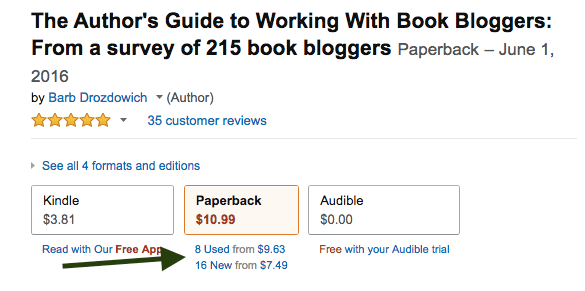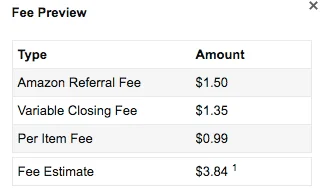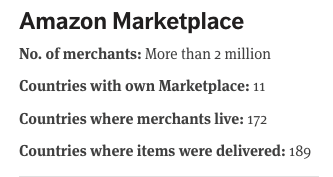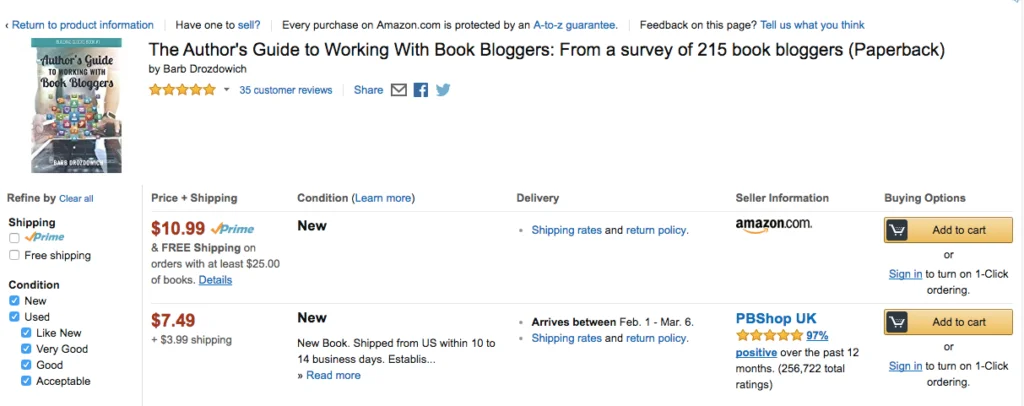When indie authors look to market their self-published books on Amazon, whether as a paperback via CreateSpace or as an ebook via KDP (or both), they're often puzzled by the additional option of the Amazon's third-party seller system known as Amazon Marketplace, and wonder whether or how it applies to their need to reach readers. Social media consultant and author advisor Barb Drozdowich solves the mystery in this clear and helpful post.
The “Third-Party Seller” system – or what Amazon calls “Amazon Marketplace” seems to be poorly understood. I’m going to use this opportunity to clear up some of this misunderstanding, and describe what is a major money maker for Amazon.
My Own Experience of Amazon Marketplace
Almost ten years ago I had several relatives pass away in a short period of time and they all left me their book collections. I’m a reader, you see…
Within a short period of time I had about 50,000 books neatly boxed up and stored in my garage. Yes, you read that number correctly! 50,000. By the time we were finished bring books home, one half of our two-car garage was filled.
Something clearly needed to be done. I couldn’t bring myself to throw away books, but the vast majority of the books were on topics that I would never read. I decided to sell them and add the money to my daughter’s education fund. The work began. I investigated eBay and Amazon and also set up my own website.
Very quickly I discovered that most of my sales came from Amazon, so I concentrated on that platform.
Seven Years On
I’ve been a third party seller on Amazon for just over seven years. I don’t sell a lot of books, but I am gradually moving my relative’s books into the hands of other booklovers.
Until I started doing a bit of reading for this post, I didn’t realize how extensive the third party seller system was. According to this article in the Seattle Times, more than two million merchants sell their goods under Amazon’s umbrella, making what Amazon calls Amazon Marketplace one of its core businesses.
How Amazon Marketplace Works
When I sell a book on Amazon, they take fees off the top, but they collect and give me money for shipping. As you can see in the graphic below, for a book that sells for $10.00, I get $3.99 for domestic standard shipping and Amazon takes $3.84 in various fees as you can see in the graphic below (I pay the postage to ship the book to the buyer). Some of the fees are fixed and some are dependent on the price. Different categories of goods have different levels of fees.
The books that I sell, I have at the house and I ship personally. Amazon also offers fulfillment – that’s where they warehouse the merchandise, ship to customers and send profits to the merchants. Those fees are higher than what I am charged.
What's in it for Amazon?
How much money does Amazon make from its Marketplace or what I call third-party sellers?
CEO Jeff Bezos refers to the Marketplace as one of the three big pillars of Amazon’s business, with third-party sales representing close to half the units sold on Amazon.
In 2015, third party sales exceeded $131 billion.
In fact, as you can see below, Amazon has more than 2 million third party merchants. Eleven of the Amazon platforms have their own Marketplace. Merchants live in 172 different countries and purchases can be delivered to 189 countries. This is clearly not just a US-only business. In fact, I’ve delivered books to 72 different countries. (I have a child who puts pins in a map when I make a sale)
In Bezos’s latest annual shareholder letter (according to the Seattle Times article) he claimed that more than 70,000 entrepreneurs have each had sales of more than $100,000/year. As Amazon claims, this allows entrepreneurs and small to medium businesses to go directly to consumers.
Here to Stay
If you haven’t already gathered, the Amazon Marketplace is very important to Amazon’s bottom line and isn’t going away. Merchants sell all sorts of products, new and used, and they do sell books. The products that they sell are listed by the individual merchants who declare the state of the item (new or used and, if used, what condition), choose the price and often include a little blurb about the product.
The merchant is policed by the purchasers who are encouraged to comment on their purchase/seller. If a merchant wants to price a used book at $1,000, there is nothing to stop them. Whether or not it is purchased is not Amazon’s problem.
What About Books?
The reason for this article being written was that questions frequently that come up on the ALLi Members' Facebook group regarding members’ books being sold by merchants other than Amazon. Books, both new and used, are being sold by Amazon’s Marketplace sellers.
There is no difference between these merchants and local bookstores.
In fact, the two used bookstores in the city that I live in sell on Amazon. To improve the buying experience in the books section of Amazon, Marketplace items are listed by ISBN and are grouped together with Amazon’s listings for that ISBN.
Example of a Book on Amazon Marketplace
To help you understand, we’ll use one of my books as an example. In the graphic below, you can see the familiar layout of a book display. This particular book is offered in 3 formats, but we’ll be looking at the paperback listing. You’ll see that I sell the book on Amazon for $10.99, but the listings indicated by the green arrow below show that there are other new and used copies available for that book.
Typically if a buyer wants a brand new book, they click on the Paperback box and then complete the sale with the orange ‘Add to Cart’ button. In the graphic below, I’ve clicked on the “16 New from $7.49” listing to show the choices. Many buyers will be attracted to the cheaper prices but still want a new book.
As you can see above, the listing will show the $10.99 price offered by Amazon at the top (my CreateSpace version) and below it is a $7.49 listing from PBShop UK, a third party seller. Is this book actually new? We don’t know, and frankly Amazon doesn’t care until the buyer complains that they bought a new book, yet got a used one.
In many cases, third party sellers will work with fairly narrow margins. This listing could be an unread new-looking copy of my book. At that price it’s unlikely to actually be new. As you can see from the graphic above, there are 16 different listings, with the prices increasing to a high of $12.99.
Some of these listings will involve the merchant purchasing a new copy from Amazon and selling it to the customer; others will be ‘like new’ copies that have been purchased previously.
Sadly, no one is trying to make thousands of dollars from one of my books. I guess I’m not famous enough.
Just like at any brick and mortar bookstore, the merchants can price books at any price they choose.
If the price is too high for what they are selling, it is unlikely that the item will be sold. But Amazon leaves it up to the third-party seller to choose what price to offer.
What About the Customer?
While what you see above is meant to be seamless to the customer, many purchasers are unaware that they are not purchasing from Amazon. Over the years, I’ve received several comments from purchasers surprised that the book was shipped by me, not in an official Amazon box.
Not only are third-party sellers allowed to do what they are doing, this activity is encouraged by Amazon. As I mentioned above, many of the sellers actually have a brick and mortar store, but are increasing their reach by listing their merchandise for sale on Amazon, making it available to millions of searchers the world over. Are all of the sellers being completely honest in their descriptions? Probably not, but like in any marketplace, the buyer needs to be aware of what they are purchasing, and Amazon has a dispute mechanism in place to handle complaints.
I hope this article helps you understand a bit better what is actually going on with book sales (and other sales) on Amazon. I’m happy to answer any questions that you have either in the comments below or feel free to contact me directly on Facebook or through the contact forms on either my business blog or my author blog.
OVER TO YOU Have you had experience – good or bad – of selling or buying books through Amazon Marketplace? Do you have any advice to add to Barb's? We'd love to know!
Ever wondered how #Amazon Marketplace works for books? @sugarbeatbc explains Share on XOTHER POSTS THAT ANSWER POPULAR QUESTIONS ABOUT AMAZON









[…] No other platform creates so much controversy or so much myth and misunderstanding. In 2017, the most significant story from Amazon this year was their decision to bring books into line with their policy across the rest of the store on 3rd party-sellers. […]
Regarding the availability of “16 New from $7.49” in my experience these types of sellers are getting them at the publisher-set whosesale rate on IngramSpark or LSI, and may even be drop-shipping. I had the same issue when I set my wholesale rate at the industry standard 55% discount on Ingram; as soon as I reset it to a much smaller discount many of these third-party sellers disappeared because they were no longer competitive with Amazon on price + shipping.
Do many writers buy Createspace PODs at their discounted prices then sell them on Marketplace? If amazon doesn’t care, does Createspace? Are there penalties?
How do you start selling with Amazon?
Barb,
Great article and explanation!
Question: Does Amazon collect sales tax from the customer and pay out to the appropriate governments? Or is that a responsibility of the seller?
Thanks!
William
I wish we had known about this when we downsized from our big house to our smaller house. We ended up practically giving away a room full of books for about 50 cents each.
Hello! Barb,
This was an easily understandable and very useful article. Thank You for posting it.
I have one perplexing to me, as a new, not quite yet published author. I am putting the finishing touches on a book that I plan to list on Amazon in two formats, ebook and paper back.
In all the articles I’ve read, it is suggested that I purchase multiple ISBN numbers. Will you help me understand why I need to buy several ISBN numbers for one book in two formats.
One more, does Amazon have a someone to help you with the cover preparation. I’ve sort of figured out what I want it to look like, but, have no idea what format or how to upload it appropriately. Any suggestions!
Thanks for any assistance you might send my way.
If you made a sweater in size 12 in red, and also in blue, each of them would have a different stock keeping unit (SKU) number in your business inventory, because they are different products. Your website might have a single page for the sweater, with choices for size and color, but once the customer has chosen, you have to uniquely identify the very specific product they chose if you want to send them the right thing in the right size and the right color.
Your book title is like that sweater page, and each format is a different product, differentiated by its own ISBN (which is a special version of an SKU number).
Very helpful summary — thanks!
I have 1400 boxes of books in storage and eventually I expect I will have to excerpt the valuables to sell at auction and do something like Amazon Marketplace with all the rest.
Assuming you are pricing at the low end, to move the books, what sort of volume do you get of purchases? In other words, if you have 1000 books listed, what percentage do you sell in, say, a year?
(Or any stats you can share…)
[…] Barb Drozdowich A crystal-clear post explaining how Amazon Marketplace can sell copies of your books at different […]
Very interesting, and good information to have. I have several hundred copies of my books (remaindered, the first printing) that are “new” and never out of the box. I’d debated what to do with them, and perhaps this would be an option. Hmnnn.
Hi Amy,
Navigating the system is a bit frustrating a first but certainly doable. I’m happy to help if you want. Just PM me. If I was you, I’d do it 🙂 Make some money instead of leaving the books in boxes.
Barb